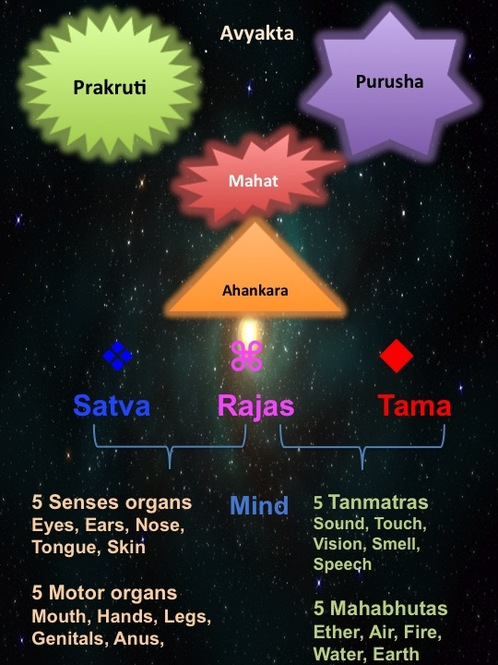
Types of Moksha According to Advaita Vedanta
Jivanmukta According to Advaita Vedanta a jivanmukta, or one who is liberated here and now, has realized that Brahman alone is real and the world is illusory.

In Sankhya philosophy, Acharya Kapila Mahamuni has described 24 principles that are involved in the formation of the Universe. These are – Avyakta, Mahat, Ahankara, Mind, 5 Sense faculties, 5 Motor faculties, 5 Great elements, and 5 Tanmatras.

Avyakta means unmanifested. The avyakta principle is the unmanifested form of pure existence. The origin of Universe is from avyakta. There are 2 main components:
Purusha is absolute, pure consciousness. It is a potential energy. Purusha does not take an active part in the creation. Purusha is the observer, a witness to the creation. It exists as a choiceless, colorless, formless non-material entity.
Prakruti is the creative, primordial, and active form that plays the main role in the creation of the Universe. Prakruti remains avyakta until its time of manifestation. Once it manifests, Prakruti takes an active creative role in the formation of the Universe.
Hence the root source in the creation of the Universe is said to be Prakruti. Prakruti is desire, an energy with the ability to differentiate and create. Prakruti has form and color. It is the mother in the creation. Prakruti cannot exist without Purusha, but Purusha can exist without Prakruti. When Prakruti and Purusha come together, they give rise to Mahat (Cosmic Intelligence).
This is the first primordial matter developed from Prakruti and Purusha. Mahat is defined as pure innate intelligence. It has self-awareness but no differentiation. Mahat is Buddhi as reasoning capacity and individual intellect.
Mahat is pure intelligence, but when it attains ego, it gives rise to Ahankara. Ahankara is associated with separation and differentiation. Ahankara is the ego, focusing more attention on “I” – the self.
From Ahankara, consciousness gets divided into 3 different qualities, also called Maha Gunas or universe qualities:
By the combination of Satva guna and Rajas guna, 5 sensory organs, 5 motor organs, and mind are developed. From Tamo guna, 5 great elements and 5 Tanmatras are developed.
These are the Jnyanendriyas:
These are the Karmendriyas:
Mind is an entity that has different qualities and performs myriad functions. It is a tool for sensory as well as motor organs and hence is referred to as the eleventh indriya. Mind is very important in the process of gaining knowledge.
Functions of mind: Thinking, analysis, problem-solving, memory, setting goals, judgment, controlling self.
Mind is extremely fast and invisible. It is only one, but sometimes, it appears as if we have multiple minds. For example, while watching a movie, we see and listen. But this is not true. As the mind is only one, it is able to perform one function at a time, but it has tremendous speed so we feel that all things are happening at the same time. Any kind of perception and functioning of sense organs or motor organs indicates the presence of mind.
For getting any type of knowledge, one requires sense organs, objects, and mind. For example, if one is reading a book but the mind is busy thinking about entirely different things, one will not be able to absorb what one is reading. Presence of mind is important for the process of knowledge. Mind possesses the qualities of Satva, Raja, and Tama.
Tanmatra is a Sanskrit word meaning “Subtle essence.” Tanmatras or the 5 subtle essences give rise to the 5 great elements. Each great element is a combination of all 5 tanmatras but shows predominance of one tanmatra. The 5 tanmatras are Sound (Shabda), Touch (Sparsha), Vision (Roopa), taste (Rasa), Smell (Gnadha). These tanmatras are related to each sense organ.
These are as follows:

Jivanmukta According to Advaita Vedanta a jivanmukta, or one who is liberated here and now, has realized that Brahman alone is real and the world is illusory.

Sanskrit texts are an important part of Hinduism and have played a significant role in the development and evolution of this religion.